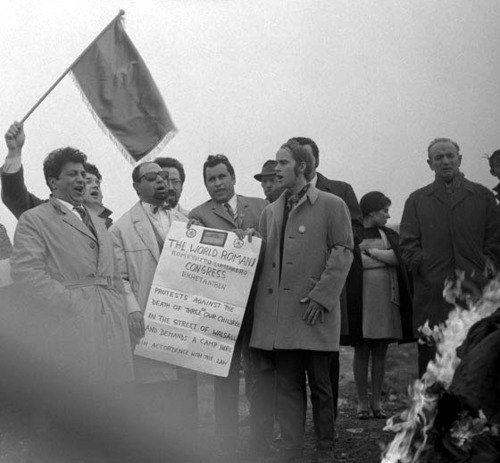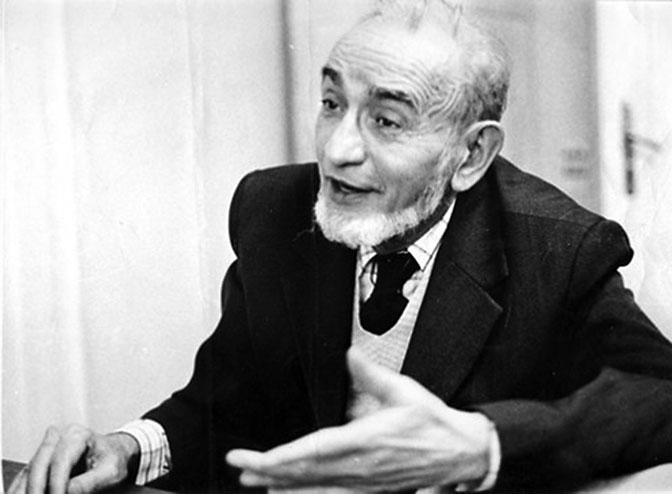
Participants at the first World Romani Congress, held in London 1971, singing the anthem “Gelem, gelem” (authored by Žarko Jovanović, white coat)
Žarko Jovanović (1925-1985). During World War II he was imprisoned in three camps. After that he joined the Yugoslav Partisans. Jovanović lost most of his family during the war. He moved to Paris in 1964.
“Nisu to bajke, nego istina”[1]: a critical appraisal of Roma politics in SFRY’s ‘golden era’
Ferdi
Was the ‘golden era’ of Yugoslav socialism also the golden era of Roma political life? In some ways, perhaps, though with some very substantial caveats. It is true enough that that certain achievements, however problematic, in the fields of Roma nationalism, ethnic rights, and legal protections were all fostered under the Communist Party’s regime, we cannot allow ourselves to be complacent with what is essentially a liberal appraisal of history. Firstly, we should recognize that these gains were fought for and won due to the political labor of people in the Roma rights movement, not gifts from the State, and secondly, the condition of the Roma in Yugoslavia was truly abysmal regardless of its relative superiority to the absolute deprivation and mass violence suffered by the Roma in neighboring countries. Finally, it is possible to trace many of the troubles currently endured by the Roma of the former Yugoslavia to the misguided efforts of the ‘socialist’ period. To be clear, it is not my intention to demonize the SFRY under which many people lived markedly better lives than they would have under the current post-socialist regimes, but to establish that the State, socialist or otherwise, cannot but reproduce exploitative hierarchical relations with its subject populations; in the case of the Yugoslav Roma, this relation was one of racism just as it remains today.
While Roma enjoyed a generally positive image as loyal partisans in the reconstruction period, Roma activism in the middle period of ‘market socialism’ was highly productive, though largely from a cultural angle. The theater Romano Phralipen opened in Skopje in 1970 and quickly became a center point for Roma voices in Yugoslavia, as was the newspaper Romano lil first published in Belgrade that autumn. The president and co-initiate of the First World Romani congress a year later, partisan hero Slobodan Berberski, was himself a celbrated poet. Under his leadership, the Congress was first encouraged to view Yugoslavia as a model State in its handling of Roma issues. The red color of the wheel on the Roma national flag is credited to his commitment to socialism[2]. The Roma had long-ago carved a cultural niche for themselves in the Balkans and it was from here that they launched their political interventions. In fact, sixty Roma organizations were founded in the 1970s, perhaps culminating in the “Listen, Roma!” radio broadcast of 1981. The visibility of Roma culture, especially Roma music, in this period was instrumental in the effort of Roma activists to transcend the vaguely defined republican category of “ethnic group” and reach recognition as a “nationality”, a murky political category that implied both representation on the federal census as well as stronger constitutional protections[3]. As respondents increasingly identified themselves as speakers of the Roma language in federal surveys, their developing identity as a nationality became increasingly legible to state bureaucracies.[4] Such distinctions were not academic to Roma activists in the republics, they were seen as a conduit to State power; nationalities, like the Albanians and the Hungarians, were essentially held in equal standing with one another from a federal perspective, equipped with full language rights, educational autonomy, and, theoretically, a stronger representational presence in the Party. A prominent question in this period was related to the possibility of an autonomous Roma province or State, the elusive “Romanestan”[5]. This question may have been fueled by Tito’s own public consideration in 1946 to giving Macedonian land to the Roma in appreciation for their “fanatical devotion to the partisan cause”[6].

Slobodan Berberski (Zrenjanin, 1919 — Beograd, 1989). Poet, Communist Partisan. Berberski led the Yugoslav Romani delegation that participated in the First World Romani Congress in London (April 1971), at which he was elected president.
The efforts of Roma activists in the socialist period were borne from genuine oppression and precarity. By 1976, the supposed golden era of gypsy equality in Yugoslavia, one in sixty Roma made it all the way to secondary school and most remained completely uneducated[7]. According to a 1978 study, Roma children suffered a fifty-percent mortality rate, eighty-percent of Roma adults failed to meet basic employment prerequisites, only one hundred out of the estimated half a million Roma in SFRY had been enrolled in university, and most Roma associations had no meeting spaces in the towns and cities where they operated[8]. Despite this, the president on the Council of Inter-Ethnic Relations in Serbia claimed that there was no “Gypsy question” because they “are all equal and enjoy constitutional rights”[9]. A 1979 commission on the “nationality question” identified ‘gypsies’ and Albanians as the only minorities suffering from active ethnic conflicts with majority populations[10]. If this was indeed the best place and time for Europe’s Roma, and perhaps it was, this should not lead us to applaud the rulers of Yugoslavia, but to appreciate the genuine horror the Roma have long faced in Europe generally.
So what did the tireless efforts of Roma activists achieve in this supposedly sympathetic socialist State? Despite the opening of Roma language schools in the republics, most notably in Macedonia and Serbia, the distance between these schools and the networks of social and political power remained insurmountable. Even ignoring the dismal working conditions of these ‘separate but equal’ programs, students who did see their way to finishing the programs found themselves afloat in a political economy based on party-affiliation, consumer buying power, and kin networks, in other words, a system entirely inimical to a precarious Roma worker. As late as the mid-1980s, high school enrollment remained at the same levels as the previous decade, only two-hundred Roma could be considered “professional workers” (doctors, engineers, lawyers, etc.)[11], and Roma unemployment remained unsurpassed by any other group, excepting, perhaps, women in general[12]. What work they could find was in the lowest paying jobs, and the slums of precarious Roma laborers became more and more visible in Yugoslav cities. For his effort to speak out against these conditions, the Belgrade home of international Roma activist Rajko Đurić was “ransacked” by the State and, after numerous death threats, he was finally forced to flee the country in 1989[13].
Unemployment, unsurprisingly, was a tricky concept for a supposedly socialist state. Susan Woodward’s unparalleled study on the subject shows how the SKJ re-invented the category in Yugoslavia, denying unemployment status to those with workable land or, in the case of women, families to take care of them[14]. While the fact that many Roma families became beneficiaries of land redistribution schemes in the 1970s and 1980s may seem positive at first blush, it can also be read as a subtle act of mass dispossession. Instead of developing the proletariat ‘gypsy’ into a modern socialist citizen as its ideological tenants should demand, the State re-invented a racialized peasantry in the country and a ghettoized precariat in the cities essentially indistinguishable from those in the capitalist West. This is should come as no real surprise if one considers Yugoslavia as part of the global capitalist system of the age and not exceptional to it. Given the country’s endemic reliance on domestic commodity consumption and foreign capital, both in the form of high-interest loans from giant capitalist organs and a constant inflow of tourism, the ultra-marginal Yugoslav Roma, living in the shadows of the country with no buying power, became increasingly racialized negatively as urban vermin and criminals or positively as ‘natural’ musicians and ‘nomads’: myths still prevalent to this day. One must only watch Emir Kustarica’s socialist-era films to see how effective the romanticization of this exploited social strata truly was.

Stevan Đorđević (1919-1943), Partisan Commander and the only Roma person to be declared a “People’s Hero of Yugoslavia”.
In real life, this condemned proletariat of an ersatz socialism became both ‘noble savage’ and ‘scapegoat’ to a nepotistic ruling class[15] and an increasingly nationalist majority population. Suffering mass unemployment, poor education, urban ghettoization, little representation, and reliant on super-precarious sources of labor, the heavy burden of the Roma in Yugoslavia demands a referendum on Kardelj’s frustrated drive to communism. Cultural rights and nationalistic politics may have created a Roma elite[16], an explicit State policy in at least one republic[17], but it did nothing to overcome the class relationship at the heart of rising anti-gypsy racism in socialist Yugoslavia. How could it? Neither racism nor class-exploitation officially existed. Instead of confronting the logical impasses of “market socialism”, that is to say, confronting the raison d’etre of the State itself, the ‘gypsies’ of Yugoslavia were naturalized as a racial ‘Other’. Their precarity would be chalked up to their supposed ‘nomadism’ or ‘work-shy’ disposition, their increasing dependence on informal and extra-legal sources of income explained by their ‘cunning nature’, and their cultural ghettoization as entertainers of the majority population was just one more sociobiological marker distinguishing ‘Them’ from ‘Us’.
If we do not accept that the Roma are somehow genetically predisposed to poverty, than we must accept the fact that they were actively oppressed in SFRY. The State did not merely fail to elevate the Roma, the State was an active agent in their precarity. This is not to say that the SKJ were somehow intentionally targeting ‘gypsies’ in the sense that their Nazi and imperial predecessors had, but as an etatist social movement, Yugoslav socialism was structurally predestined to reproduce the same inequitable relations as the capitalist macrocosm that fed it. From the perspective of a racialized minority, the difference between an ideologically socialist ruling class and an ideologically imperial or capitalist one is merely a matter of policy, not a radically different structure. Identical scapegoating and ghettoizing mechanisms reign in any social order that relies on the centralization of political power; legitimizing the rule of a few relies partially on naturalizing the subjugation of the many, as well as the hierarchical subdivisions of labor therein. While ‘gypsies’ absorbed the brunt of the ‘market socialist’ experiment in its ‘golden era’, all Yugoslavs would collectively confront its failures in its final bloody years, and along the same ethnic, nationalist, and racist lines as their ‘gypsy’ compatriots.
It might be objected at this point that the State should not be made culpable for the racism of its citizenry. To this, I urge the reader to avoid drawing too deep a distinction between the State and ‘the People’; these are co-constructed entities. As much as the State is a reactionary assemblage of bureaucratic machinery and violence, it is also a popular social movement. A great number of people must agree to undertake the mission of the State, employing its enforcement mechanisms, relying on its direction, identifying as a constituent of it, and situating that constituency relative to its benefits and proximity to the apex of the State’s conical power structure. The State is the face of the government, yes, but it is also the way we face each other[18]. As Yugoslavs constructed and reproduced the cultural category of ‘gypsy’, they moved closer to the center of power, stepping over their neighbors in the process. Likewise, the Yugoslav State, in the capitalist mode, reproduced the ‘gypsy’ by sublimating its crises into a racial/cultural scapegoat, externalizing its inability to employ or properly care for the people who allow it to rule. Thus, beograđani to this day chide one another for “acting like a gypsy” when they do something foolish or improper, culturally re-enacting this original sacrifice and imagining a clean ‘Serb’ against the counter-image of a dirty ‘gypsy’ – one who is part of the system versus one who is an outsider in it.
Given the necessity of such informal policing in the maintenance of ‘the nation’, it should be no surprise that nationalism is endemic to formal policing as well. The wars of the 1990s arrived, in each instance, under the auspices of nationalist police forces. One might be tempted to point out that post-revolutionary Yugoslavia never actually rid itself of the rank-and-file police that collaborated with the Nazis in the holocaust of Jews, Roma, and partisans[19], but by the ‘golden era’ we are dealing with an entirely new generation of forces. This is easiest to explain in the specific context of Serb nationalism. Despite having grown up ‘under socialism’ as Yugoslavs, the rank-and-file milicija and special forces of Aleksander Ranković’s sprawling security apparatus[20] established an overwhelmingly Serbian police state in Kosovo, though one that merely replicated police forces elsewhere in Serbia and traditionally Serbian regions of Yugoslavia. The effectiveness of his tactics on the consciousness of Serb nationalists was made undeniably clear upon his purging from the SKJ in ‘66 for spying on Tito and other party members. Dobrica Ćosić, whose coalition of intellectuals prefigured the nationalist takeover of the Serbian Academy of Sciences and Arts in the 1980s, turned Ranković into the “protector of the Serbs”, arguing that the “peasants are on Ranković’s side”[21]. While the overtly Serbian character of the police and their predecessors has been apparent since the Belgrade Čukur fountain incident of 1862, Ćosić’s propaganda tied Serbian identity closer than ever to the police state. When we consider the already crushing prejudice and marginality of Roma life in Tito’s Yugoslavia, it is not difficult to imagine how an openly nationalist police force could exacerbate both their exploitation and exclusion as a precarious Other well after Ranković was purged.
Perhaps even more sinister is the way in which the Roma, in this bleak condition, were made into quasi-mascots for a number of interests in the SFRY, especially among Serbs. I’ve already mentioned their depiction in Kustarica’s films as noble savages, but the problem neither begins nor ends on the silver screen. Anthropologist Mattijs van de Port showed how gypsy musicians were employed for cathartic performances as the ‘wild soul’ of Serbs in Novi Sad as late as the early 1990s. “Gypsies represent what we are,” claims one of his middle-aged Serb informants, “although we are not allowed to be it”[22]. These sentiments are echoed in earlier ethnographic works of the SFRY as well; Sharon Zukin’s 1976 informants claimed that Serbs and ‘gypsies’ were “soul brothers” and that many Serbs thought of themselves as “very close to gypsy temperament”[23]. Esma Redžepova, the celebrated Roma singer originally from Macedonia but later based in Belgrade, was crowned “Queen of the Roma” in India in a dual effort towards Roma nationalism and Non-aligned Movement diplomacy. Indeed, a simple search of the term “cigan” in the annals of Yugoslav popular music would reveal the ubiquity of the concept in the collective consciousness of the time. Even the ultra-nationalist war criminal Vojslav Šešelj applauded the contributions the Roma have made to Serbian culture in his Hague tribunal; in his trial, Šešelj twisted the supposed Serbian tolerance of the Roma to emphasize the racism of Croats and the longevity of the Roma ethnicity to argue for the arbitrariness and artificiality of the Bosnian nation[24]. Today, anti-ciganism has taken an almost entirely negative turn, but the positive racism of Socialist Yugoslavia played a role in the discourses of nationalism and ethnicity that were integral to the etatist politics of the ‘golden era’ as well as the period of crisis that followed it.
There is no State solution for racism. Despite nearly achieving legal equality in the Socialist Federal Republic of Yugoslavia, the vast majority of Roma, those who were not celebrated as cultural elites, remained an invisible proletarian reserve of highly exploitable labor living in utmost deprivation and precarity. The stakes of power in etatist politics are exclusive; the dispossessed mass is a precondition of the existence of the State as well as its regenerative base. Roma in other ‘socialist’ states suffered targeted sterilization, pogroms, and the forced rupture of kin networks in an attempt to solve the “gypsy problem” by either eradication or assimilation into a larger national body. Yugoslavia went another route; the SKJ created a representational system based on ethnic and national identity, hooked it into the markets and debt structure of global capitalism, and produced a ruling State class with hegemonic power over the relations of production, and called this “socialism”[25]. Gypsies posed a conceptual threat to this system by their highly visible collective poverty, their reward for loyal partisanship. Thus, their suffering was re-branded as cultural exoticism and put to work attracting those vital tourist dollars and selling Yugoslavia as the tolerant socialist haven it, perhaps, never really was.

[1] This title is borrowed from a statement made by the iconic Roma singer Šaban Bajramović, “Inspiraciju za pjevanje nalazim u temama iz svakodnevnog života, našeg romskog. Ja pjevam tu istinu i onda ta istina pogađa. Nisu to bajke, nego istina. Jer, kada pjevam, naši Romi plaču i pjevaju i vesele se.” In English, “I find inspiration for singing in themes from everyday life, our Roma life. I sing that truth and that truth is striking. They are not fairy tales, but the truth. Because when I sing, our Roma cry and sing and rejoice.”
[2] Marushiakova, Elena and Vesselin Popov. The Roma – a Nation Without a State? Historical Background and Contemporary Tendencies. Mitteilungen des SFB 586 „Differenz und Integration“ 6. Page 80.
[3] With the exception of Bosnia and Montenegro, who had no such definition, ‘ethnic group’ was “reserved for disperse minorities like the Roma who were perceived as lacking strongly constructed external national homelands”. (Sardelic, Julija. “Romani Minorities and Uneven Citizenship Access in the Post-Yugoslav Space” Ethnopolitics, Vol. 14, 2015.
[4] Crowe, David. 1996. A history of the gypsies of Eastern Europe and Russia. New York: St. Martin’s Press. p.226
[5] The idea of an independent territory for Roma and Sinti might have originated with a letter to the editor in an 1868 issue of the Ottoman Balkan newspaper, Macedonia, where a writer called Ilia Naumchev advocated for Gypsies, as an “ancient people” to join the nationalist drive of the era and develop their own society (Marushiakova and Popov. Ibid. Page 72.). This matured in the 1920s and ‘30s among the so-called ‘gypsy kings’ of diasporic groups settling in Poland who asked the UN for land in Namibia for this purpose (Ibid. 76.). Failing this, a delegation was dispatched to Mussolini asking for land in occupied Abyssinia (Ibid. 77.). Given the fascist connection, perhaps it is not so surprising that Heinrich Himmler may have been the most prominent proponent of this idea; he argued that “pure blooded gypsies” should receive land where they can live “according to their customs and traditions” (Eric Ames, et al. Germany’s Colonial Past. 2005. Page 177). This mini-State was to be in Burgenland, between Austria and Hungary (Marushiakova and Popov. Ibid. 77.). Himmler’s interest, of course, was more zoological than political, though it should be noted how similar fascist ideas of ‘racial states’ are to liberal ideas of ‘nation states’. Tito’s suggestion of a “Gypsy autonomous area in Macedonia” (Crowe. Ibid. 222.) differs both in spirit and intention from Himmler’s proposal, but the logic of natural cohesiveness of a discrete people, be it an “ethnic group”, “nation”, or “race” remained relatively unaltered.
[6] Crowe, David. 1996. A history of the gypsies of Eastern Europe and Russia. New York: St. Martin’s Press. p.222
[7] Puxon, Grattan. Gypsies: Blacks of Eastern Europe. The Nation. 1976
[8] Crowe. Ibid. 227.
[9] Ibid. 228.
[10] Jović, Dejan. 2009. Yugoslavia: a state that withered away. West Lafayette: Purdue Univ. Press. p. 187.
[11] Crowe. Ibid.229.
[12] Woodward, Susan L. 1995. Socialist unemployment: the political economy of Yugoslavia, 1945-1990. Princeton: Princeton University Press.
[13] Ibid. 231.
[14] Woodward. Ibid.
[15] For a study on the class composition of Socialist Serbia’s ruling strata, see: Lazic, Mladen. Old and New Elites in Serbia. Serbia Between Past and Future. 85.
[16] Sardelić, Julija. 2013. ‘What’s in a name?’ The dilemmas of re-naming Yugoslav gypsies into Roma. CITSEE EU web magazine.
[17] Sardelic, Julija. 2016. Roma between ethnic group and an ‘underclass’ as portrayed through newsparer discourses in socialist slovenia. Social inequalities and discontent in Yugoslav socialism., eds. Rory Archer, Igor Duda and Paul Stubbs. Abingdon; New York: Routledge.
[18] This is written in the spirit of Gustav Landauer, who argued, “The state is a social relationship; a certain way of people relating to one another … The absolute monarch said: I am the state. We, who we have imprisoned ourselves in the absolute state, must realize the truth: we are the state!”
[19] Pisarri, Milovan. 2014. The suffering of the Roma in Serbia during the holocaust. p. 138.
[20] Ranković’s power came mostly from his tenure as the minister of the interior as well as founder of both the OZNA and UDBA.
[21] Bešlin, Milivoj. The opening of the national issue. Nacija kao problem ili rešennje. 53.
[22] Port, Mattijs van de,. 1998. Gypsies, wars and other instances of the wild: Civilisation and its discontents in a Serbian town. Amsterdam: Amsterdam University Press. 225.
[23] Zukin, Sharon. 1975. Beyond marx and tito theory and practice in Yugoslav socialism. New York: Cambridge University. p. 225.
[24] United Nations International Criminal Tribunal. Šešelj (IT-03-67). Record 8301-8305. June 17.
[25] See: James, C. L. R.. State Capitalism and World Revolution. 1969. and Woodward, Susan. Socialist Unemployment. 1995.
